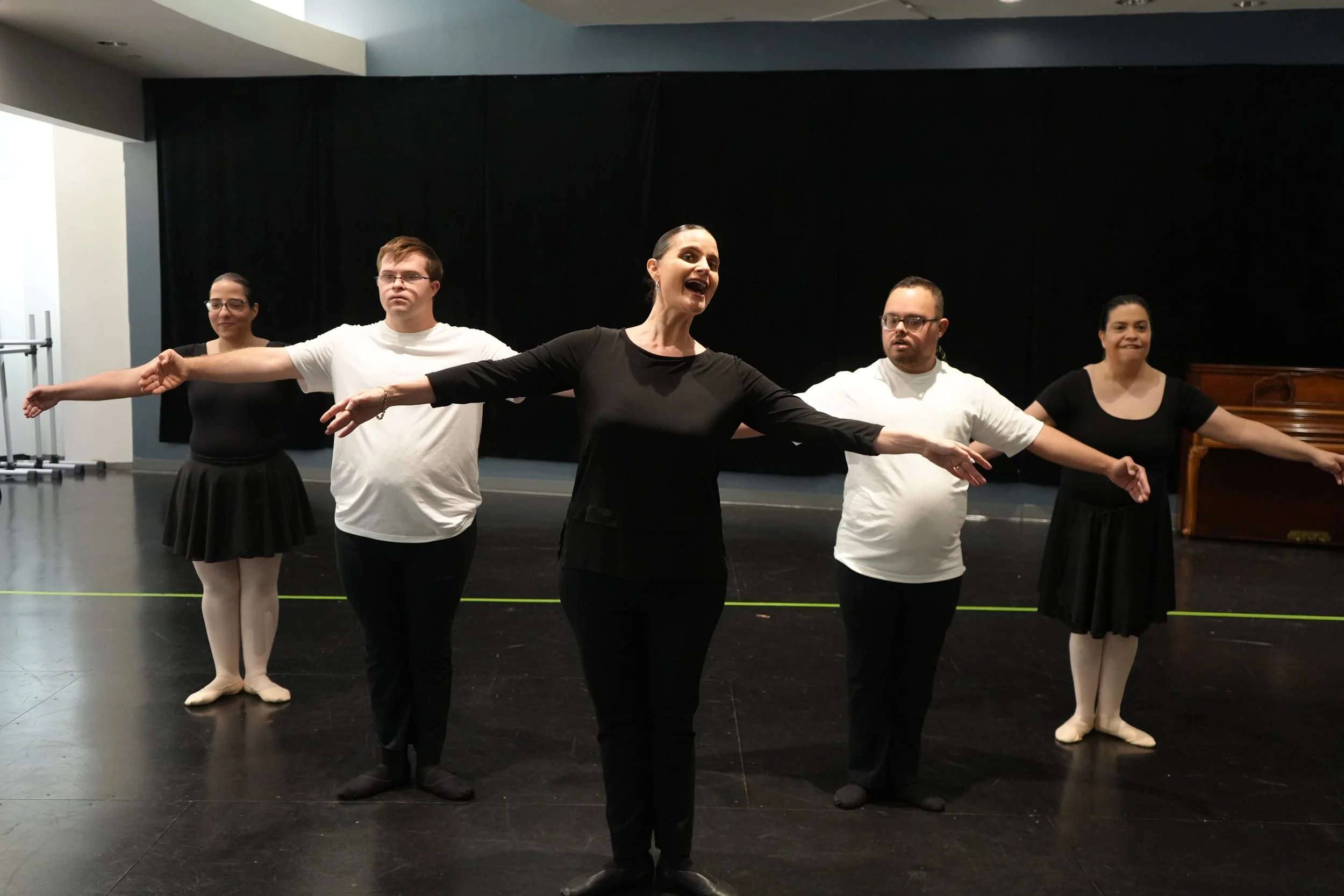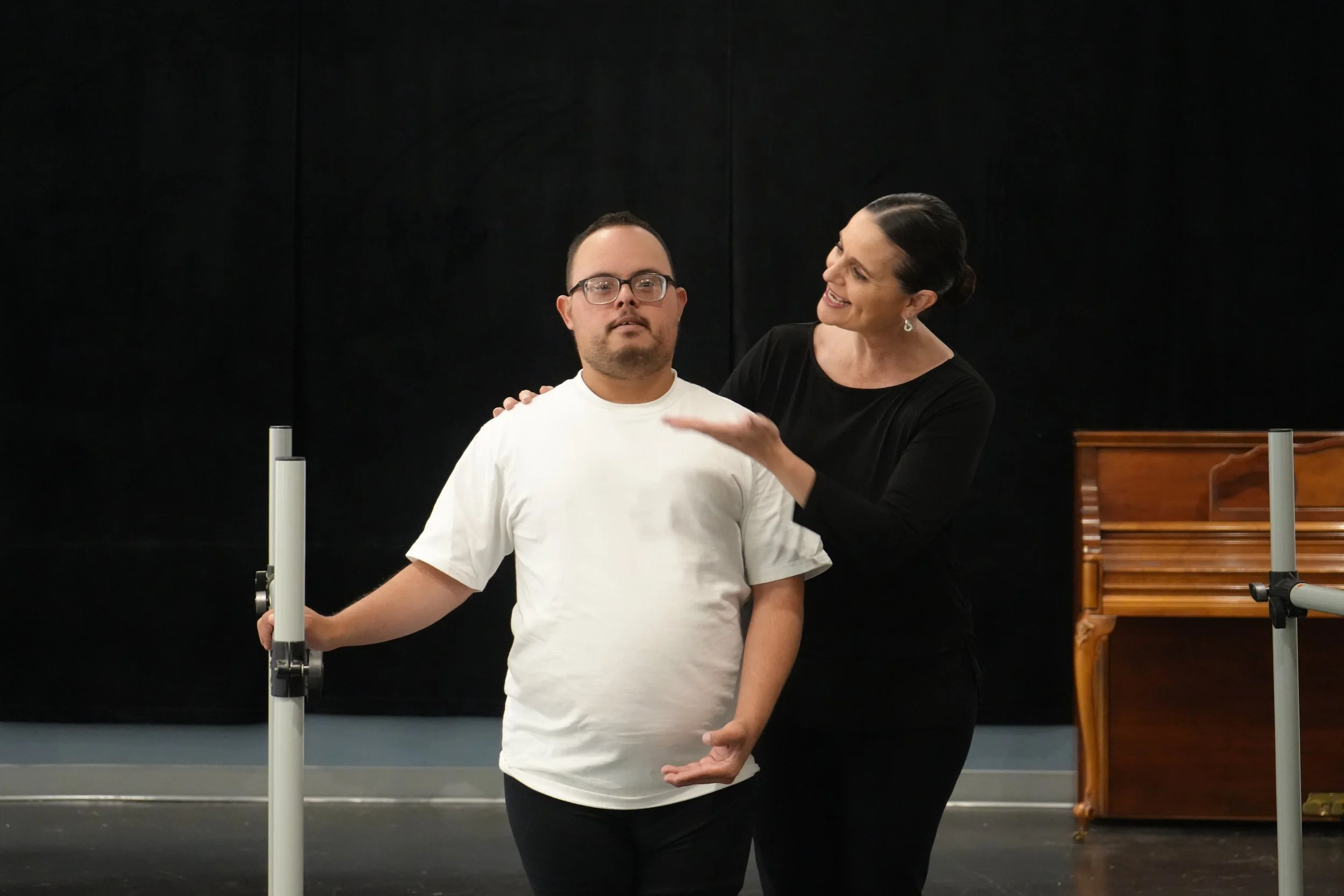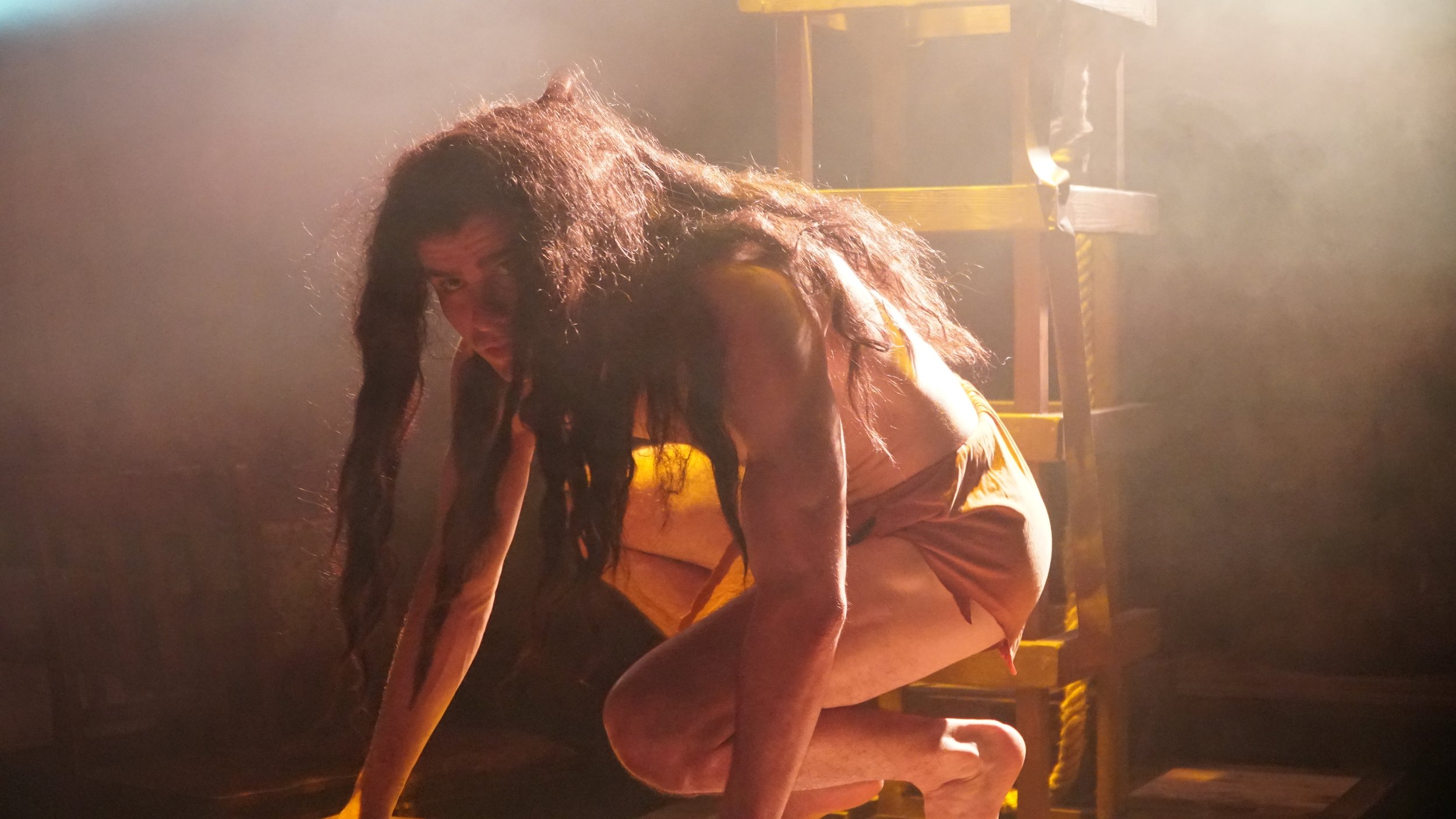Like those earlier works, Tarzan doesn’t envelop every audience member at every moment — not every scene plays out inches away. But the design remains immersive in intention and execution. Audiences aren’t passive spectators; Rodaz places them inside a shifting jungle of sound, movement, and tension. You might be steps from a fight or a romantic moment — or feel the air shift as Tarzan swings overhead. Even when the action unfolds across the room, you’re still inside its world — watching it breathe and pulse around you. Rodaz varies the pacing so that more introspective, moving material truly lands and touches us.
For instance, early on, Kala — the titular character’s gorilla mother — lies on a hammock with her infant, rocking gently while singing the soothing, lullaby-like, award-winning song “You’ll Be in My Heart.” She holds the baby Tarzan close to her body as she sings to him. Kala (a tender, motherly Katie Duerr, who also serves as the production’s music director) finishes the song with an audible whisper of the word “Always.” The whisper reinforces Kala’s sincere devotion to her child.
A similarly quiet yet touching moment comes during the song “I Need to Know.” In it, young Tarzan (a sensitive Grace Suarez) despairs after Kala’s husband, Kerchak, disapproves of the boy’s actions. “I Need to Know” calls to mind “Where Is Love?” from Oliver! — in both numbers, children sing as they seek affection and clarity in a confusing world.
As young Tarzan sings:
Will someone tell me where I belong? Where I should go?
Can someone tell me where I’m going wrong? I need to know.
Why would I hurt the ones I love? Why would I hurt you?
If I can’t be what he wants of me, what am I to do?
When will I be me, the son that he can’t see?
There must be somebody who understands. Out there, somewhere.
Suarez delivers the number soulfully, with quiet yearning, in a voice that sounds like it belongs to a boy. A puppet stands in for Tarzan as a child — a choice that might seem simple, but proves effective. Puppetry is one of the ways Rodaz directs economically, relying on minimalism without sacrificing creativity or emotional impact.
In addition to being action-packed, creative and touching, this production is humorous. Watch and listen, for instance, as the actors portraying gorillas observe with wonder a typewriter they see before them. Suddenly, one of them touches the machine and rushes back in shock. During another moment, the titular character learns to speak English. As others slowly, in a loud, drawn-out manner, instruct him in proper pronunciation, you may understandably laugh. These scenes may even call to mind the familiar image of an American slowly — and loudly — trying to communicate with someone who doesn’t speak English.
Sometimes, the actors portraying Tarzan and Jane don’t speak; they simply observe each other in awe, reflecting on how they are different, yet alike in other ways. Thanks to Rodaz and the actors, these pauses featuring non-verbal communication are just as touching as scenes with spoken words.
The duality of man and beast is one of the key themes in Tarzan. Rodaz and the cast deftly illustrate this theme through movement. In particular, the performers sometimes walk on two feet, while at other times, they crawl on all fours. In addition, the actors portraying beasts sometimes speak English, and at other times communicate in beast-speak, which may sound like nonsense to many of us.
All of this reinforces the notion that we have baser, impulsive urges in addition to more human, rational tendencies. Certainly today, in 2025, we have experienced beast-like tendencies in many individuals, although kinder, human qualities still exist. Quality live theater can remind us that goodness persists in the world — even alongside baser instincts.
In Tarzan, an inner tug-of-war between human and beastly tendencies forces the titular character to question his true identity. As we watch this show, we can’t help but think that the real beast is not any of the gorillas, but the scientist/explorer Clayton. This may call to mind another Disney show — Beauty and the Beast. You may recall that many think the true beast in that show is Gaston.
In this production, the titular character (Coby Oram) and Jane (Siena Worland) pore over a book, which may instantly cause you to recall lively scenes involving books and literature between the titular beauty and the title beast.
Certainly, Jane is a British woman who is as vibrant and curious as Belle in Beauty and the Beast. In Worland, Rodaz has chosen a gem of a performer to play this key character. Worland, sporting red lipstick, a yellow outfit, and with blonde poking out from beneath her hat, looks as radiant as she sounds as Jane. The actor radiates enthusiasm, wonder, curiosity and similar such qualities that people with a zest for life share. And we sense that Jane feels for Tarzan as he must decide between the human world and the one in which he grew up. Also, it’s clear that she is as curious about Tarzan and the apes as they are about her.
The dynamic between Tarzan and Jane may call to mind shades of My Fair Lady. Jane plays a role akin to Professor Higgins — guiding Tarzan’s introduction to speech and civilized society. Yet unlike the pompous Higgins, Jane is curious and openhearted, and ultimately transformed as much as Tarzan is.
Worland shares strong chemistry not only with Oram’s Tarzan — whom she helps introduce to human society — but also with her onstage father, Professor Porter. John Luis Mazuelos imbues Jane’s father with enthusiasm and a touching sensitivity. Mazuelos gives Professor Porter a human quality, something that is lacking in the 1999 animated movie, which portrayed Jane’s father as basically a fool.
Characters such as Jane and her father, Professor Porter, are joyful, bright presences, whereas Kerchak and Clayton are darker. To his credit, Frank Montoto finds just the right shade of darkness to bring Kerchak and Clayton to life. As Kerchak, Kala’s husband, a commanding and severe Montoto makes it clear who is in charge. And his mistrust of Tarzan comes across loud and clear. As the explorer, Montoto conveys believable arrogance and you sense greed in him. Like Gaston in Beauty and the Beast, Montoto’s Clayton is the true beast in Tarzan.
Speaking of the title character, Oram excels physically and vocally in the role. With long strands of dark hair and often wearing no top, this performer looks fit and moves with vigor. Whether he’s climbing a ladder or swinging from a rope, Oram’s fearless Tarzan is a sight to behold. The actor also believably conveys Tarzan’s sense of wonder, awkwardness and inner conflict. We sense he is truly torn between the human world and the universe in which Kala raised him among the apes.
Another major character is Terk, Tarzan’s loyal and lively best friend. Imran Hylton plays him with deft comedic timing and charisma.
While Terk still cracks wise and bursts into high-energy numbers such as “Trashin’ the Camp,” Hylton humanizes the character. This Terk isn’t just comic relief — he’s a genuine friend. Indeed, he is wrestling with the fear of being left behind as Tarzan drifts toward the human world. Hylton plays the tension with subtlety, revealing not just humor but heart. The result is a Terk who is as memorable for his loyalty as he is for his laughs.
In the final analysis, ASC, under Rodaz’s expert guidance, has crafted yet another believable immersive show filled with humor, heart, energy, and humanity. This production captures the spirit of Tarzan while making it fresh and immediate for today’s audiences. With its strong performances and inventive staging, it’s sure to resonate long after the curtain falls. Look for it to receive at least one well-deserved award nomination.
Tarzan from Area Stage Company through Aug. 10 at The Shops at Sunset Place, second floor, 5701 Sunset Drive in South Miami, performing 7 p.m. Thursday–Sunday and 2 p.n. Saturday-Sunday. Tickets: $52.75–$124.75, depending on seating. For more info, visit www.areastage.org.












